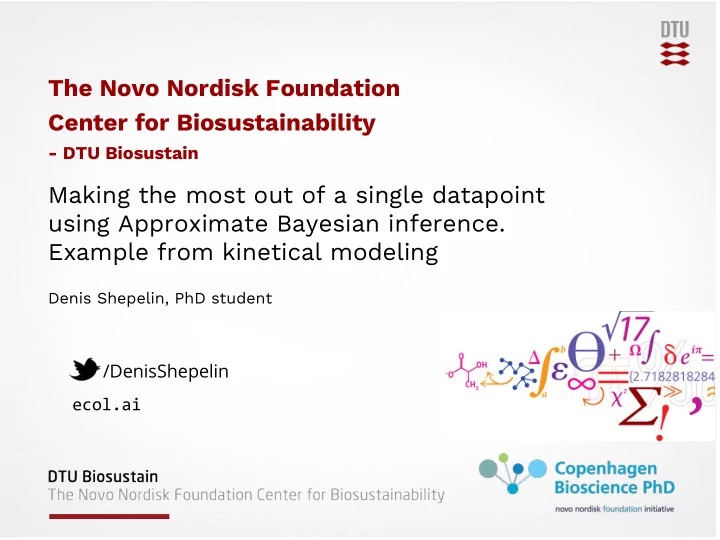

The Novo Nordisk Foundation Center for Biosustainability - DTU Biosustain Making the most out of a single datapoint using Approximate Bayesian inference. Example from kinetical modeling Denis Shepelin, PhD student /DenisShepelin ecol.ai
Biotechnology Food (Beer, Dairy, …) Drugs (Insulin, Herceptin, ...) Chemicals (Plastics, fuels, ...) Biotechnology can be used in almost any industry DTU Biosustain, Technical University of Denmark
Cell factories. Enzymes and fluxes Sugar Plastics Glycerol Fuels Waste Drugs ... ... Chemical conversion Glucose Spandex by Luigi Chiesa - Own work, CC BY 3.0 DTU Biosustain, Technical University of Denmark
Chemicals in cell How many molecules go through reaction - flux ( Δ G) Governed by enzymes Substrate Product DTU Biosustain, Technical University of Denmark
Biotechnology the modern way (Un)surprisingly hard! https://doi.org/10.1016/j.ymben.2015.09.013 DTU Biosustain, Technical University of Denmark
Data available to biologists We have tools to define and explore structure of metabolic network given organism genome - we know which reactions are there and what Techniques to measure sets of molecules simultaneously - “-omics” technologies 1. Metabol omics - abundance of chemicals (metabolites). Usually ≈ 100s of features per sample. 2. Prote omics - abundance of proteins (enzymes) . Usually ≈ 1000s of features per sample. 3. Flux omics - estimates of reaction fluxes . Usually ≈ 100s of features per sample. Data is noisy. Sometimes we are not sure about noise structure (Not Gaussian) DTU Biosustain, Technical University of Denmark
Describing metabolism. Chemical kinetics. Thermodynamics Thermodynamics ( Δ G) - possibility of reaction, kinetics - speed of reaction Metabolic network structure as transport problem Chemical transformation as kinetical equations Linear programming problem System of ODEs Using Genome-scale Models to Predict Biological Capabilities; https://doi.org/10.1016/j.cell.2015.05.019 https://derekcarrsavvy-chemist.blogspot.dk/2016/02/reaction-kinetics-5-kinetics-and.html DTU Biosustain, Technical University of Denmark
Generalized Monod-Wyman-Changeux model MWC describes chemical kinetics accounting for many kinds of events - is very complex and hard to fit Formulation, construction and analysis of kinetic models of metabolism: A review of modelling frameworks 10.1016/j.biotechadv.2017.09.005 DTU Biosustain, Technical University of Denmark
Generalized Monod-Wyman-Changeux model MWC describes many kinds of events - is very complex and hard to fit Most of parameters we can measure! x - concentrations of metabolites E - abundance of enzyme (it is protein), can be in active (T) or inactive state (R) v - reaction flux Other parameters we can sample or want to fit k ’s are parameters specific to reaction ( to be fitted ) L describes proportion of active enzyme (can be sampled) - we need ( Δ G) here Q is a function describing how enzymes can be activated and inactivated Formulation, construction and analysis of kinetic models of metabolism: A review of modelling frameworks 10.1016/j.biotechadv.2017.09.005 DTU Biosustain, Technical University of Denmark
ABC reminder Original problem ABC “likelihood” where K is kernel accounting for the distance between simulated sample and true data https://casmls.github.io/general/2016/10/02/abc.html DTU Biosustain, Technical University of Denmark
ABC-GRASP. Methionine cycle study Comparatively small system, has very detailed models => good starting point 5 ODEs + 1 algebraic equation, 72 parameters An Allosteric Mechanism for Switching between Parallel Tracks in Mammalian Sulfur Metabolism, https://doi.org/10.1371/journal.pcbi.1000076 DTU Biosustain, Technical University of Denmark
Case study - ABC-GRASP Construction of feasible and accurate kinetic models of metabolism: A Bayesian approach, doi:10.1038/srep29635; A General Framework for Thermodynamically Consistent Parameterization and Efficient Sampling of Enzymatic Reactions doi:10.1371/journal.pcbi.1004195 DTU Biosustain, Technical University of Denmark
ABC scheme Smart choice of priors helps with sampling and defines structure. Priors are consistent with rules of thermodynamics DTU Biosustain, Technical University of Denmark
ABC scheme Parameters from the prior satisfy basic rules of chemistry => We save time not trying to do unrealistic simulations Rejection Sampler -> Sequential Monte Carlo (experimental) DTU Biosustain, Technical University of Denmark
Training the model Simulate data via published and verified model yielding 12 “samples”. Change values of concentrations, enzyme abundancy or flux DTU Biosustain, Technical University of Denmark
Results. Properties and Predictions Training is fast, after two points very little changes DTU Biosustain, Technical University of Denmark
Results. Properties and Predictions Even prior contains very valuable information. Some analyses can be performed without any data. Note that after 2 points posterior changes very slightly. DTU Biosustain, Technical University of Denmark
Results. Properties and Predictions Inexact parameter fit provides accurate predictions. We are interested in predictions! DTU Biosustain, Technical University of Denmark
Identification of omitted rules Some interaction between compounds and reactions are removed (grey dotted arrows). DTU Biosustain, Technical University of Denmark
Identification of omitted rules Add interactions one-by-one to corrupted model. Use Bayes Factor to decide what is possible deleted interaction BF > 3.0 Interaction recovered DTU Biosustain, Technical University of Denmark
Challenges 1. Computational load 2. MATLAB as environment 3. Diversity of samples - hard to control 4. How to share and communicate resulting model 5. How to scale solution to higher dimensions 6. Complicated prior (involves several linear programming routines) DTU Biosustain, Technical University of Denmark
Moving forward Hamiltonian MC with information about gradients? (Graham & Storkey, 2017) Switch from Monte-Carlo to Variational Bayes methods? (Moreno, 2016) Probabilistic programming libraries as foundation for next-gen tools? (TensorFlow probability, Pyro, …) We are very happy to hear your suggestions! DTU Biosustain, Technical University of Denmark
Conclusions 1. We can use prior knowledge of problem structure. 2. We can use complex models within ABC framework. 3. Prediction accuracy vs parameter estimation accuracy. 4. Not all data points are equal. 5. It’s still tricky to set up and perform ABC the right way. But! there is lots of progress in the field. DTU Biosustain, Technical University of Denmark
ABC packages ELFI (implements BOLFI) (Python) pyABC from Helmholtz Centrum (Python) ABCpy (Python) al3c (C++) PEITH( Θ ) + abc-sysbio (Python) abctools (R lang) DiffEqBayes.jl (Julia) DTU Biosustain, Technical University of Denmark
Recommend
More recommend